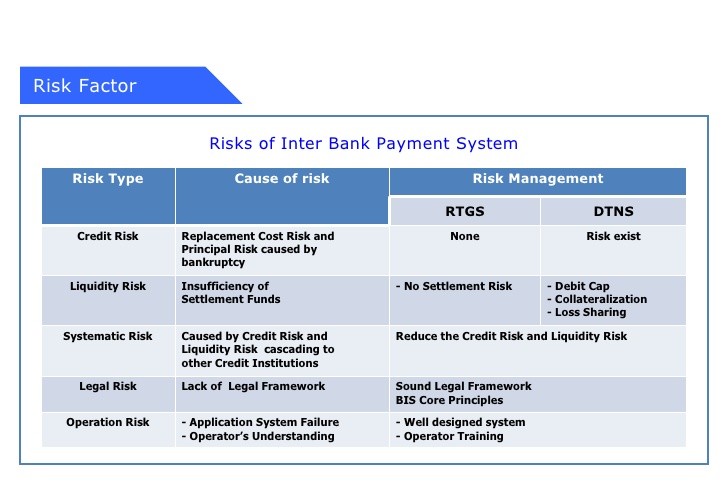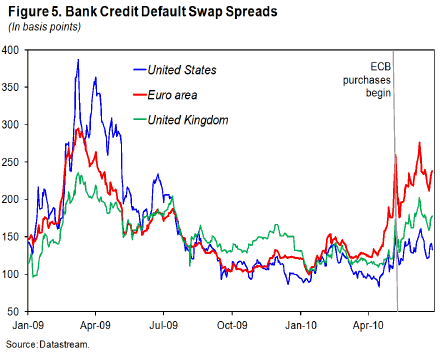Introduction to Risk in Banks and types of risk
Post on: 6 Июнь, 2015 No Comment

Risk in Banking:
Introduction:
Banks are involved in the trade of borrowing and lending for various periods at different interests and engage in many other interest related undertakings, dealing in foreign exchange, undertaking different investments, dealing in the derivative markets etc. Due to its line of work the banks are subjected to an array of risks like no other institution.
The risks encountered by Banks are usually identified in the statue/s relating to banks in many countries, and are as follows
- Interest rate risk
- Market risk
- Liquidity risk
- Credit Risk
- Currency risk
- Counterparty risk
- Operational Risk
Exposure to these risks makes for the banks being the most controlled and supervised of any financial institution. It will be evident that bank regulators are required to be proficient and astute in the industry of banking. It is essential that they be aware of innovations and global trends.
In most countries the statute/s relating to banks makes it mandatory that banks have a vigorous risk management function, and that the board of directors has a risk management committee.
The Concept of Risk:
I would not be wrong in stating that Banks owe their existence to risk. They well may be referred as risk machines. So what can you describe as a risk?
Risk is the chance that an investments actual return will be different than expected. Risk includes the possibility of losing some or all of the original investment. Different versions of risk are usually measured by calculating the standard deviation of the historical returns or average returns of a specific investment. A high standard deviation indicates a high degree of risk.
Many companies now allocate large amounts of money and time in developing risk management strategies to help manage risks associated with their business and investment dealings. A key component of the risk management process is risk assessment, which involves the determination of the risks surrounding a business or investment. Bonds are considered to be the safest form of investment and rather a risk free investment but the returns are equally minimal. Higher the risks, higher are the returns.
A question may come to mind at this point of the article
Whether there is way to reduce risk without compromising return?

The answer is a resounding “YES”, the risk is reduced by diversifying the portfolio provided that the assets in the portfolio are not perfectly positively correlated, and that the risk is further reduced as correlations move from +1 to -1. Banks tend to be very well diversified.
Some of the main types of risks have been discussed below
Interest rate risk:
It is the risk of expected earnings being influenced negatively as a result of changes in the pattern and level of interest.
There are three elements to interest rate risk:
- The bank margin. Banks endeavour to get highest rates they can negotiate on assets, and the lowest rates they can negotiate on liabilities; the difference between these is the bank margin.
- The interest rates are either floating or fixed
- The term to maturity of the fixed rate assets and liabilities.
Market Risk (also called position risk, trading risk and price risk) is the risk of a decline in the market value of financial securities (shares, debt and derivatives) that is caused by unexpected changes in market price and interest rates, and changes in credit spreads.
Liquidity Risk:
Liquidity risk for a bank is the risk of not being able to meet obligations in terms of funds demanded by clients. This applies to both sides of the balance sheet of banks, i.e. to withdrawals of deposit and to loans drawn down by borrowing clients in terms of loan commitments made by the banks.
It is also known as default risk, and it is the risk type to which the average bank is principally exposed, as a result of the makeup of its assets portfolio. Bank’s loans typically comprise the largest portion of their assets.
Credit risk is the risk that the borrower from a bank will default on the loan and the interest payable, i.e. that it will not perform in terms of the condition under which the loan was granted. This is damaging to the bank, not only because of the actual loss eventually incurred, but also in terms of the time that management and bank counsel expend on attempting to recover the loss or a portion of the loss.
Currency Risk:
It is also called foreign exchange risk. Certain financial intermediaries asset portfolios are made up of domestic and foreign securities. In the case of the latter the portfolio will usually include foreign bank deposits and securities such as treasury bills of the US and UK governments. In addition to their foreign portfolios, banks also play a major role in the spot, forward and derivative forex markets. Internationally, banks also have liabilities in foreign markets. Their exposure to currency risk can be devastating on their profitability and to their capital position.
Counterparty Risk:
Each party to a deal has a party on the other side of the deal. Thus, each party is the counterparty to the other party, and each party s exposed to the other in that the other party may renege on the deal or be a fraudulent party to the deal as the unsettled deal. This risk is termed counterparty or settlement risk.
Operational Risk:
Each bank has its unique definition of operational risk. The following are the elements of operational risk-
- Information technology systems risk
- Human Resource risk
- Reputation risk
- Compliance risk
- Legal and documentation risk
- External risk
Due to constraints of space these are not discussed further but will be discussed in future articles.
To summarise it all Banks must take risk in order to be attractive as an investment. The trick is the risk-reward-trade-off. It is for this reason that the management rule of the banks in respect of risk should be such that the risk taking process is not constrained to the extent that risk is eliminated. Financial Intermediaries as such banks cannot be too prudent.














